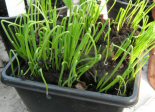
 | ||||||||||||||||||||||||||||||
| ||||||||||||||||||||||||||||||
TOUCHWOOD
SOWING INFORMATION
click here for sowing advice for aquilegias
Information on fern sowing is given below.
SOWING INSTRUCTIONS
HOW? Sow as usual.
For me that means in 3” pots, thin as
necessary, and transplant out into trays/the garden/ growbags when large enough but not too large (especially concerning root growth). I usually use peat based
 general purpose mix (as it’s cheap), but use John Innes for seed likely to take a time to germinate (eg hellebores), or where the seedlings will be in the same compost for a time, such as bulbs. …although I’ve also sown into growbag compost! I also sow a lot direct into nursery rows in the garden.
general purpose mix (as it’s cheap), but use John Innes for seed likely to take a time to germinate (eg hellebores), or where the seedlings will be in the same compost for a time, such as bulbs. …although I’ve also sown into growbag compost! I also sow a lot direct into nursery rows in the garden.
WHEN?I’m a big believer in sowing whenever it suits yourself.
I’ve always sown from Jan to May,
although am experimenting with summer/autumn sowing dates. Nursery-row sowing I tend
to do from March to
May.
Nursery-row sowing I tend
to do from March to
May.
HEAT?I usually sow almost everything ‘cold’, just in my unheated greenhouse (which protects seed pots from cats, and me from the weather!). Some things that are not fully hardy (such as Nicotiana, Cleome, Passiflora), I’ll use a bit of bottom heat to start, and a week or so on my windowsill.
GERMINATION REQUIREMENTS
LIGHT: campanulas, primulas, helianthemum, iris, oenothera, lobelia, mimulus, nicotiana, verbascum, lettuce, begonias, grasses, conifers.
DARK:mirabilis, nigella, angelica, pansy, phacelia, some primulas
SOW EARLY: all roseaceae, bulbs, angelica, aquilegias, astrantia, meconopsis, penstemon, primulas
FRESH:Angelica, anemone, astrantia, corydalis, hellebores (need warm then cold period), fritillaria, primula
Here's a link to an article on sowing
SOWING FERN SPORES
Growing ferns from spores can be as easy as growing anything from seed, just a little slower and longer! The spores germinate to firstly produce a prothallus which looks rather like moss or liverwort growth. (We must therefore ensure we exclude moss/liverworts.) This is the sexual phase of a fern, rather like a flower in other plants. But it needs no wind nor insects to pollinate and fertilise it, merely damp surroundings. The tiny fernlets start to grow from the prothallus and in time gives a full-sized fern. So what do we do?SOWING INSTRUCTIONS
1)
Put on the kettle to boil a couple of pints of water.2) Gently firm peat-based compost into a new (or scrupulously clean) pot. Don’t use old compost, I use 1 Litre pots as it gives a good surface area for sowing and is more stable than 3” pots.
3) Put prepared pot in sink and poor boiling water over to sterilise. This will disturb your flat surface, to prevent that, you can first cover with a kitchen towel. Reserve enough hot water for a cuppa!
4) Allow to drain and wait several hours to cool. Otherwise you will merely cook the spores!
5) Place pot on saucer and sow the very fine spores as evenly as you can! DO NOT sneeze, cough or even breathe!
6)
Place an upturned polythene bag over the pot...even better use a sealable freezer bag.
This will stay in place for a long time and may need replacing! Maintains moist atmosphere, and prevents unwanted moss/liverwort/fern spores from entering.
7)
Leave on non-sunny windowsill, watering from below if necessary. I use a west-facing sill, not greenhouse, as I forget to water!
8)
After 4 or more weeks the green ‘mossy’ prothallus grows and after a couple of months you will see baby fernlets.
9)
When large enough (or too crowded!) prick out into pots of compost, sterilised as before. DO NOT prick out individually but as about 1cm-across ‘scoops’ of prothalli plus fernlets. Again cover with upturned polythene bag.
10) About a year or so after sowing(I said it was slower!) You will be ready to harden off, prick out individually, and plant outside.
They will still be small but you will have a ‘forest’!
Any problems or worries about fern-sowing, ring me to discuss on 01792-522443. Good luck, -Carrie-
GUARANTEE
I fully expect you to enjoy a good germination from my seeds. If that is not the case, please let me know, for either information and advice, replacement seed or a credit note. But when you do get good results…please tell your friends and let them benefit from good seed of cottage garden, rare and unusual plants at a brilliant price!!
| Home | Seed-List | Aquilegias | Plants & Seedlings | Video | Contact me |
| Talks | Sowing | Gardening | Garden Visits | Labels | Order forms |
| Smudge | Articles | Essences | Greeting Cards | Healing | Links |
